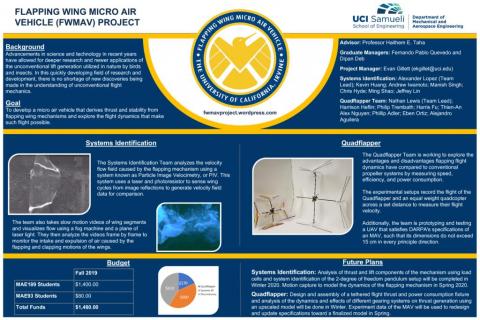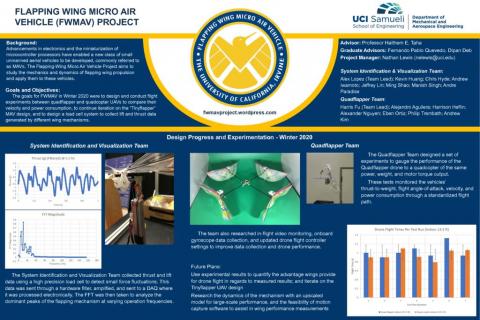Flapping-Wing Micro Air Vehicle (FWMAV)
Background
Recent years have brought about many advancements in science and technology that enabled deeper research into the mechanics and applications of reciprocating wing lift generation, as observed in nature in the flight of birds and insects. This quickly developing field of research and development provides no shortage of new discoveries to be made in the underlying mechanics of unconventional flight.
The overarching goal of the FWMAV Project is to discover and understand the advantages that flapping wings have over the traditional lift generation of rotary wing aerial vehicles. To do this, we are developing a micro air vehicle that derives its thrust and stability from flapping wing mechanisms. With these flapping mechanisms we also aim to analyze the flight dynamics and fluid flow that make such propulsion and stability possible.
Goals and Objectives
To coincide with the project's namesake of a Micro Air Vehicle, the combined work of both subteams is to develop an MAV that derives its thrust and stability solely from a system of reciprocating wings. Each sub team works to pave the way to a fully functional wing-based unmanned aerial vehicle, which requires an advanced control system, an efficient and effective source of thrust, and an eloquent design with proper flight tuning and reactivity.
Systems Identification Team
The Systems Identification Team aims to perform meaningful research into the fluid mechanics and kinetics of flight achieved through flapping mechanisms.
Particle Image Velocimetry
- The Team models the velocity flow field over the wings in motion using a fog machine and laser light, which allows them to record and calculate the instantaneous velocity of fluid particles in the air.
- The team then analyzes how the flow field evolves at different points of the flapping cycle to quantitate its performance using LabView.
Load Cells
- The team also aims to conduct an experiment to measure the lift and thrust developed by flapping wing mechanisms during specific parts of a cycle using precision load cells.
- To do so, they redesigned and upgraded a test rig to collect measurements of the forces generated by a grounded flapping-wing engine using an arduino sensor, system amplifiers, measurement DAQ, and SolidWorks CAD software.
Quadflapper Team
The goal of the Quadflapper Team is to perform quantitative comparison tests between a “quadflapper” and a traditional quadcopter. The quadflapper modifies the design of a traditional quadrotor UAV by replacing each rotary blade with a reciprocating four-wing mechanism. The most refined version of the quadflapper weighs 45 grams, develops a thrust to weight ratio of 2.4:1, and can achieve a flight duration of 3 minutes. The Quadflapper Team has built an equivalently weighted quadcopter integrated with the same motor specifications to make proper, scientific comparisons between both flight systems.
Horizontal Flight Test
- This experiment gathers both vehicles’ horizontal flight velocity through a course, and records the time of flight and angle of attack.
- The quadflapper has the advantage of being able to fly nearly horizontally compared to the quadcopter, and this strength is one primary aspect we wish to quantify.
Thrust and Power Efficiency
- This experiment aims to compare the power efficiency of the systems using integrated first-person-view (FPV) camera feed to demonstrate both systems' characteristics, and determine the value of the innovation and drawbacks to flapping wings versus traditional propellers.
Tinyflapper
- After these tests are concluded, the team will continue to iterate upon and finalize the design of the “Tinyflapper” MAV developed in the previous quarters to establish and improve its continuous flight and stability.
For more information, visit our project site at
https://cookieforest.wixsite.com/fwmav
Team Contacts
Nathan Lewis - Project Manager
nelewis@uci.edu
Harris Fu - Quadflapper Team Lead
fuha@uci.edu
Alexander Lopez - Systems Identification Team Lead
aklopez3@uci.edu
Advisor
Dr. Haiethem Taha
hetaha@uci.edu


